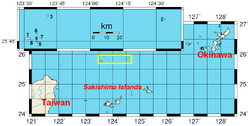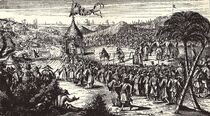| Imperial State of Formosa 臺灣帝國 | ||||
| ||||
| Anthem Formosa! 福爾摩沙 | ||||
 | ||||
| Capital city | New Anping | |||
|---|---|---|---|---|
| Official language(s) | Mandarin Taiwanese Hokkien Hakka Formosan languages Fuzhou dialect | |||
| Demonym | Taiwanese and/or Tungningese, Formosan | |||
| Government | Absolute monarchy | |||
| - King | King Tai | |||
| - Zongli | N/A | |||
| Legislature | Taizhenguan (太政官) | |||
| Established | 12 February 2015 | |||
| Population | 49 | |||
| Currency | Formosan Yen | |||
The Kingdom of Tungning (Chinese: 東寧王國; pinyin: Dōngníng Wángguó), also known as the Kingdom of Taiwan (Chinese: 台灣王國; pinyin: Táiwān Wángguó) and/or Kingdom of Formosa, is an island micronation constituting the Diaoyutai Islands. The Kingdom of Tungning, originally based in southwest Taiwan, now governs the islands of Diaoyutai, which makes up over 99% of its territory. Neighboring states include the People's Republic of China to the west, Japan to the east and northeast, and the Republic of China to the south. The government of the Kingdom of Tungning is an absolute monarchy with New Anping as its the capital city and seat of the authority.
The micronation is an archipelago of 8 islands. The four largest are Diàoyú Dǎo, Huángwěi Yǔ, Nán Xiǎodǎo, and Běi Xiǎodǎo, which make up about ninety-seven percent of the territory's land area. Tungning's population of 49. Tungning's territory of Diaoyutai's minor features in the East China Sea are located approximately 120 nautical miles northeast of Taiwan, 200 nautical miles east of the Chinese mainland and 200 nautical miles southwest of the Japanese island of Okinawa.
Since 2015, the Kingdom of Tungning has claimed that the Diaoyutai Islands are independent from Japan and under authority of the Kingdom of Tungning. However, the Japanese authorities denied the claim. Furthermore, the Kingdom of Tungning claimed that its government is the legitimate authority of the whole of Taiwan. However, the Government of the Republic of China denied the legitimate claim.
Etymology[]
The Kingdom of Tungning is sometimes known as the Cho dynasty (Chinese: 曺王朝; pinyin: Cho Wángcháo) or Cho Family Kingdom (Chinese: 曺王國; pinyin: Cho Shì Wángguó).
During Koxinga's era, the Kingdom of Tungning was sometimes known as the Zheng dynasty (Chinese: 鄭氏王朝; pinyin: Zhèngshì Wángcháo). At the time, Taiwan was referred to by Koxinga as Tungtu (Chinese: 東都; pinyin: Dōngdū).
In the west, the Kingdom of Tungning is referred as the Kingdom of Taiwan (Chinese: 台灣王國; pinyin: Táiwān Wángguó) and/or Kingdom of Formosa.
History[]
Koxinga era[]

Koxinga receiving the Dutch surrender on February 1, 1662
In 1661, Koxinga forced a landing at Luerhmen, Taiwan. In less than a year, he took Fort Zeelandia and made an agreement with Frederick Coyett, the Dutch governor. The Dutch gave him the fort and left all the goods and property of the Dutch East India Company behind. All the Dutch people, officials and soldiers were able take their personal things and supplies back to Batavia in safety. This ended 38 years of Dutch colonial rule on Taiwan. Koxinga kept himself busy making Taiwan into a useful base for anti-Qing Dynasty supporters who hoped to get the Ming Dynasty back to power. This ended 38 years of Dutch colonial rule on Taiwan. Koxinga kept himself busy making Taiwan into a useful base for anti-Qing Dynasty supporters who hoped to get the Ming Dynasty back to power.

Koxinga as ruler of the Kingdom of Tungning
In 1662, at the age of 39, Koxinga died of malaria. Some people said that he died in a sudden fit of craziness when he heard about the death of his father under the Qing. His son, Zheng Jing, took control as the ruler of Taiwan, with the name of Prince of Yanping.
For the next 19 years, Zheng Jing tried to run the country and rebuild his army in Taiwan. Contact with the Kangxi Emperor of the Qing Dynasty from China through ambassadors was frequent. Zheng Jing fought the Qing to defend Xiamen, Quemoy and the Pescadores islands, which he finally lost over the years. His small army was not big enough to defend the islands from the Qing. During Revolt of the Three Feudatories, Zheng Jing started an attack in the Fujian area. At the end of the revolt, Zheng's army was defeated. After the defeat, Zheng went back to Taiwan where he spent his time with wine and women, dying soon after of illness. After his death, his generals and ministers were split into two groups, each supporting one of his sons to take take over. After some fighting, Zheng Keshuang, his 12 year old son, became the new king.
In 1683, after the Battle of Penghu, Zheng Keshuang gave himself up to the Qing. His kingdom was added to the Qing Dynasty as part of the Fujian Province.
Reformed era[]
Around January 2015, the Cho dynasty moved forward to separate the Diaoyutai Islands (also known as Senkaku) from Japanese control in order to re-establish the Kingdom of Tungning and use the islands as a base.
On 12 February 2015, King Tai proclaimed the re-establishment of the Kingdom of Tungning and declared himself as the King of Tungning. However, King Tai delayed the accession rites until 6 months later in August 2015, a dress rehearsal was sabotaged. Soon after, King Tai started handing out titles of peerage to his closest relatives and friends, as well as those whom he thought he could buy with titles.


